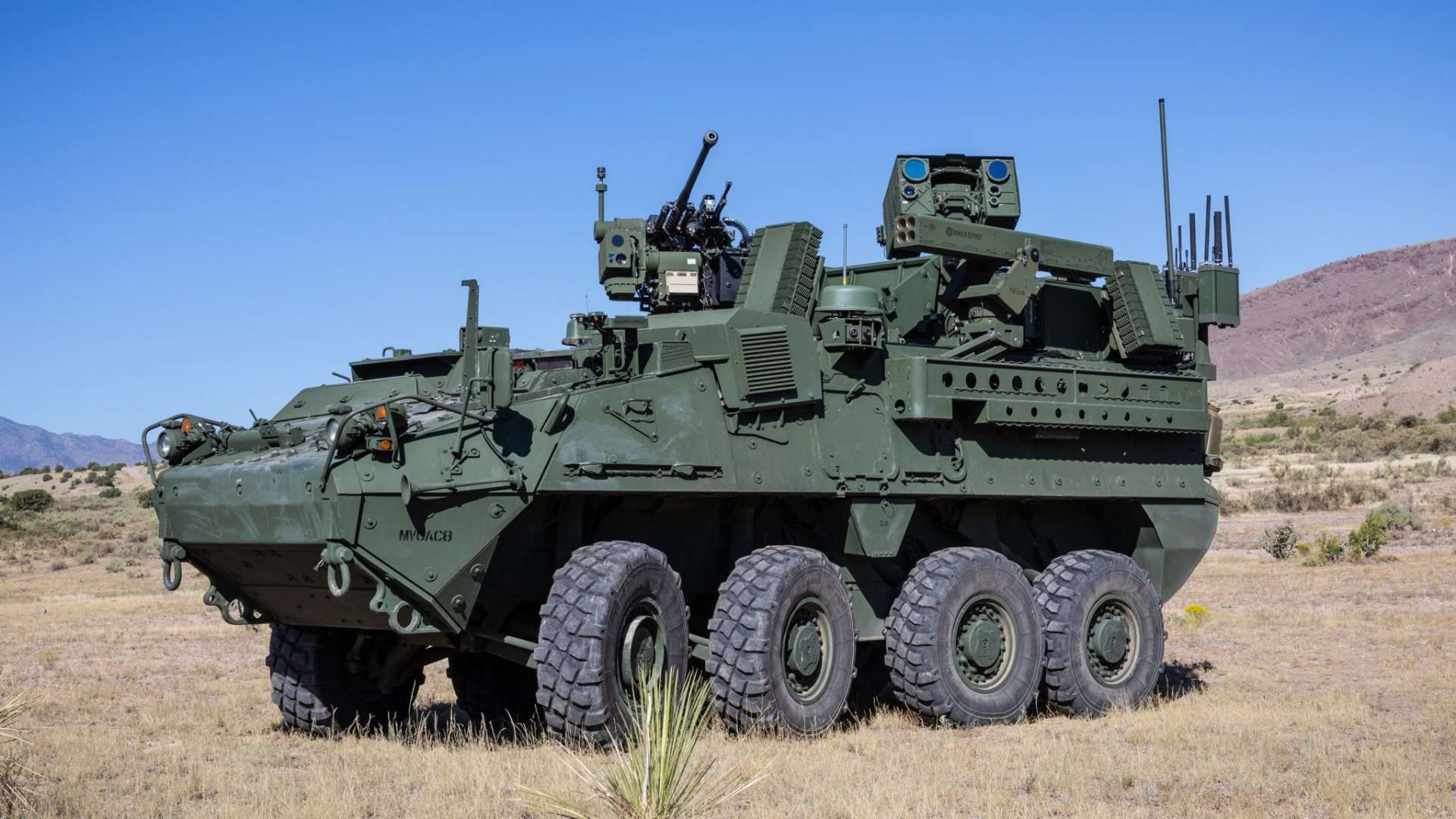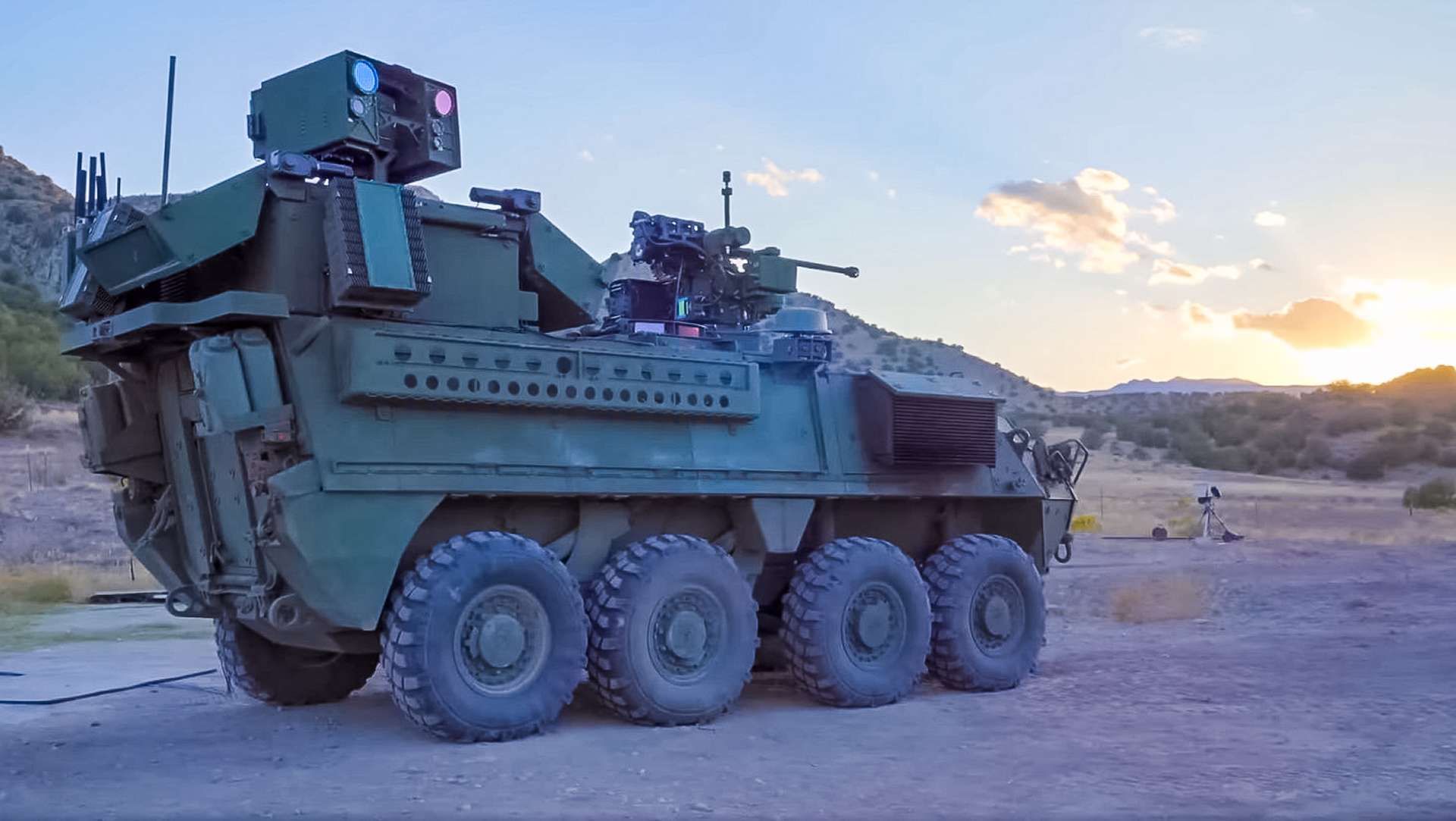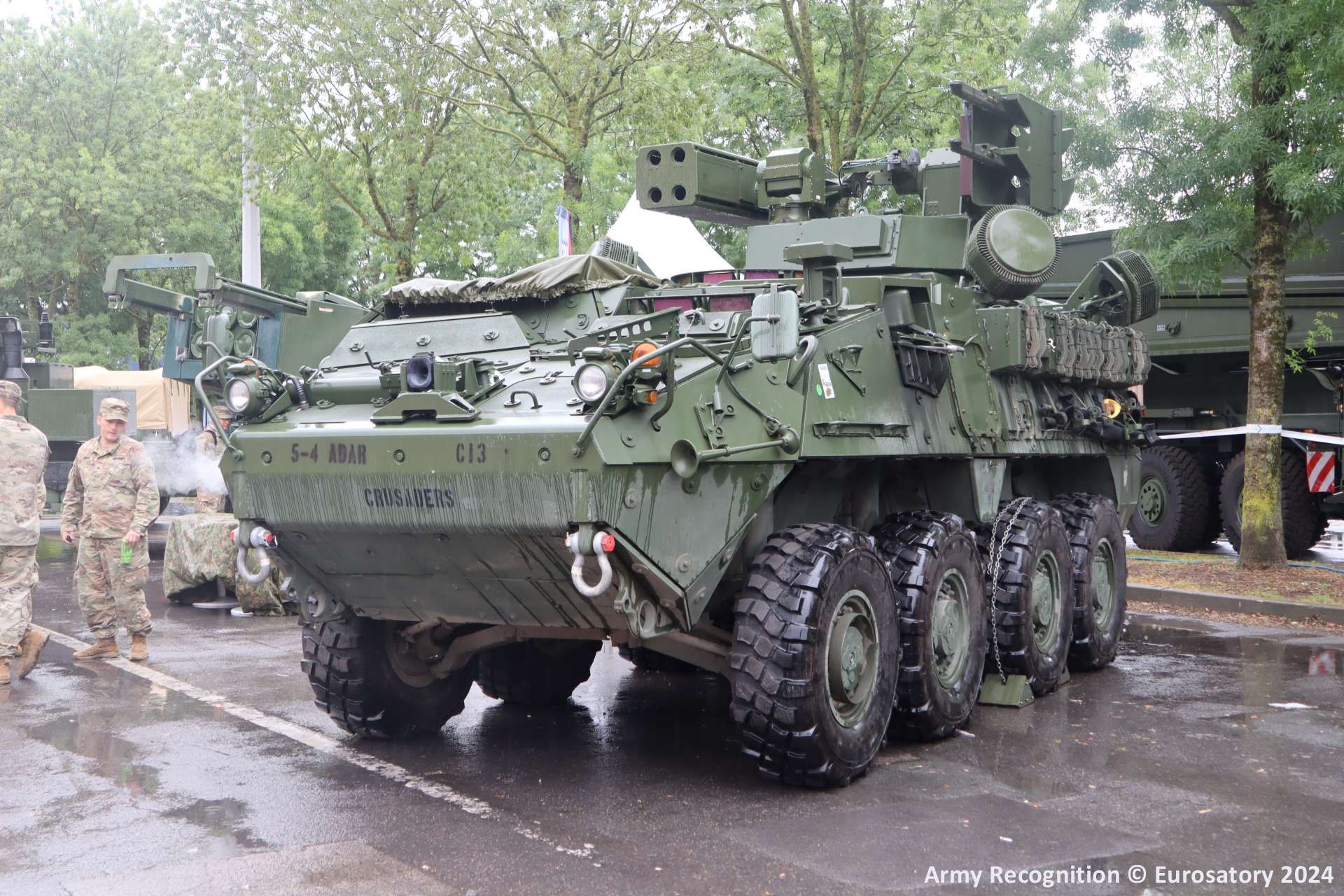Breaking News
Leonardo DRS and BlueHalo reveal new laser-armed Stryker C-UAS DE to intercept drones up to 463 km/h.
On October 14, 2024, Leonardo DRS and BlueHalo revealed a new variant of the Stryker 8x8 Infantry Combat Vehicle (ICV), known as the Counter-Unmanned Aircraft System (C-UAS) Directed Energy (DE) Stryker. This version, presented at AUSA 2024, is equipped with a laser-directed energy weapon, laser-guided 70mm rockets, a 30mm automatic cannon, and various radars and sensors. The companies recently conducted a live-fire demonstration of the C-UAS DE Stryker, successfully neutralizing Group 1-3 UAS targets.
Follow Army Recognition on Google News at this link

Presented at AUSA 2024, the C-UAS DE Stryker is equipped with a laser-directed energy weapon, laser-guided 70mm rockets, a 30mm automatic cannon, and various radars and sensors (Picture source: Army Recognition)
This demonstration took place last month in Socorro, New Mexico, in front of U.S. Army officials. During the demonstration, the mobile C-UAS system employed BlueHalo’s 26kW Locust Laser Weapon System to destroy multiple drones over two days. The demonstration highlighted the C-UAS DE Stryker’s capabilities through near-simultaneous C-UAS and ground engagements, utilizing both the laser weapon and a 30mm remote weapon station (RWS) to engage targets with consistent success.
According to Leonardo DRS, this directed energy weapon, mounted on a retractable platform at the rear of the Stryker, can engage Group 1, 2, and 3 uncrewed aerial systems (UASs), countering drones up to 600 kilograms in weight, reaching altitudes of 5,486 meters, and speeds up to 463 kilometers per hour. The Locust Laser Weapon System is a 26kW laser developed by ATA, which emphasizes mobility and rapid deployment. The Locust system integrates beam control, alignment, power, and thermal regulation elements within a compact, skid-mounted design, allowing it to be moved by standard vehicles like forklifts and pickup trucks.
Operational within 15 minutes of deployment, the Locust LWS is controlled by a single operator through a network-based interface. Its modular design allows for rapid replacement of individual subassemblies, supporting minimal downtime. With a scalable output power range of 2 to 20 kW, the system defends against multiple aerial threats, assisted by a pulse-Doppler, electronically scanned radar for 360-degree coverage, supporting counter-UAV operations, air defense, and hostile fire detection.

With a scalable output power range of 2 to 20 kW, the Locust laser system is operational within 15 minutes, and is coupled with a pulse-Doppler, electronically scanned radar for 360-degree coverage. (Picture source: BlueHalo)
The system’s SWIR camera provides frame rates between 500 and 2,500 Hz with a 3x zoom, and it includes an eye-safe laser rangefinder for precise tracking. An illuminator with adjustable spot size improves imaging in various conditions. Acquisition sensors operate at 120 Hz with a resolution of 1280 x 720, covering both visible and MWIR spectrums, enabling broad field tracking of small targets.
The adaptable power system can utilize battery, generator, or shore power configurations, and includes an integrated cooling system that enables over 100 seconds of continuous lasing with a 25% duty cycle. The gimbal provides 360-degree azimuth rotation and an elevation range from -30 to +90 degrees, allowing wide tracking capabilities.
Aaron Hankins, Senior Vice President and General Manager of Leonardo DRS Land Systems, emphasized the system’s rapid development timeline, as Leonardo DRS collaborated with seven other industry partners (BlueHalo, EOS Defense Systems USA, Northrop Grumman, BAE Systems, Arnold Defense, AMPEX, and Digital Systems Engineering) to develop the prototype in approximately eight months. Now, it is presented at the AUSA 2024 exhibition as a potential option for the U.S. Army, which is particularly interested in new laser-armed solutions to strengthen its short-range air defense (SHORAD) capabilities.

The Stryker C-UAS DE is also equipped with two primary kinetic effectors (the R400S remote weapon station (RWS) armed with a 30mm chain gun, and a 70mm laser-guided rocket launcher), as well as a Next-Gen Multi-Mission Hemispheric Radars (nMHR) and a 360° camera. (Picture source: Leonardo)
The Stryker C-UAS DE also includes two primary kinetic effectors: the R400S remote weapon station (RWS) from EOS Defense Systems USA, which is armed with Northrop Grumman’s XM914 30mm cannon, and BAE Systems’ 70mm laser-guided Advanced Precision Kill Weapon System II (APKWS II) rockets, mounted on the rear left side of the hull. These rockets are launched from a four-round launcher by Arnold Defense, featuring proximity-fuzed warheads optimized for counter-drone missions. Additionally, the C-UAS DE Stryker integrates the RPS-92 Next-Gen Multi-Mission Hemispheric Radars (nMHR) and a 360° camera, providing long-range detection and continuous tracking to enhance targeting effectiveness for air and ground threats.
The R400S RWS employs a 30 x 113mm cannon with a range of up to 2 km and is designed for lighter weight compared to similar systems. The XM914 Bushmaster Chain Gun, used in this setup, is a 30mm automatic cannon based on the M230 gun. It can fire percussion-primed 30x113mm rounds as well as electric-primed rounds like the M788 and M789. The XM914 reaches a firing rate of 200 rounds per minute, with additional proximity and guided medium-caliber rounds under development to broaden its threat engagement capabilities.
The R400S system includes day and thermal imaging sensors, with detection ranges exceeding 13,700 meters and identification ranges up to 4,700 meters. Its 4-axis stabilized gimbal provides accuracy during target engagement, even while in motion, and is equipped to engage a range of targets, including small and medium UAS. It is configurable for single or dual weapons, such as machine guns, automatic grenade launchers, or missile systems like the Javelin missile launcher, allowing configuration changes within an hour.

The R400S is configurable for single or dual weapons, such as machine guns, automatic grenade launchers, or missile systems like the Javelin missile launcher, allowing configuration changes within an hour. (Picture source: EOS)
Complementing the Locust system, BlueHalo’s Titan C-UAS and Titan-SV non-kinetic technologies enhance 360-degree threat detection and mitigation for Group 1 and 2 drones. BlueHalo’s Portfolio President, Mary Clum, highlighted the modular and integrative capabilities of the Locust LWS within the Stryker platform. This project showcases collaboration across multiple companies, including Leonardo DRS, BlueHalo, EOS Defense Systems USA, Northrop Grumman, BAE Systems, Digital Systems Engineering, Arnold Defense, and AMPEX.
Designed for interoperability, the C-UAS DE Stryker integrates with the U.S. Army’s Forward Area Air Defense Command and Control (FAAD C2) network, ensuring compatibility with other air defense systems. This platform brings together a range of technological capabilities from industry partners, aimed at providing soldiers with the necessary mobility, firepower, and protection to operate effectively in contested environments.
Ed House, Senior Director of Business Development at Leonardo DRS, emphasized that directed energy weapons reduce dependence on conventional ammunition and offer an effectively unlimited magazine depth due to lower costs per engagement compared to traditional surface-to-air interceptors. House noted that these systems have fewer logistical constraints, though cooling and recharging times are required between engagements. According to Leonardo DRS, this capability aligns with U.S. Army objectives of minimizing reliance on expendable ammunition.

During the demonstration, the C-UAS DE Stryker employed both the laser weapon and a 30mm remote weapon station (RWS) to engage and destroy multiple Group 1, 2, and 3 drones over two days. (Picture source: BlueHalo)
Despite recent advancements, directed energy programs within the U.S. military have encountered operational challenges, especially with mobile high-powered systems. For instance, in March, the U.S. Army deployed a Stryker variant equipped with a 50-kilowatt Raytheon laser, called the Directed Energy Maneuver-Short Range Air Defense (DE M-SHORAD), to the Middle East. During a Congressional briefing, Assistant Secretary of the Army for Acquisition, Logistics, and Technology Doug Bush noted issues such as heat dissipation and wear in mobile tactical environments, highlighting that fixed-site laser installations have demonstrated greater reliability.
The C-UAS DE Stryker represents a continued effort to refine mobile directed energy systems for counter-drone roles, addressing challenges identified in previous tests. Alongside the DE M-SHORAD, the Army fields a baseline M-SHORAD variant, now called the Sgt. Stout, equipped with Stinger heat-seeking missiles, radar-guided AGM-114L Hellfire missiles, an XM914 cannon, and AESA radars. Named in honor of Medal of Honor recipient Sgt. Mitchell William Stout, the original M-SHORAD system marks the first increment of the program, with the DE M-SHORAD as Increment 2.
Increment 3 of the M-SHORAD program plans to incorporate new counter-drone capabilities such as APKWS II rockets and Raytheon’s Coyote counter-drone interceptor. The fourth increment, now in planning, envisions a lighter platform that could be air-dropped or transported by helicopter, expanding the Army’s airborne and airmobile options. This increment may involve a 4×4 Joint Light Tactical Vehicle (JLTV), which Rafael also uses for its Lite Beam laser, or a robotic ground vehicle, depending on specific configuration requirements.

The US Army fields a baseline M-SHORAD variant, now called the Sgt. Stout, equipped with Stinger heat-seeking missiles, radar-guided AGM-114L Hellfire missiles, an XM914 cannon, and AESA radars. (Picture source: Army Recognition)


























